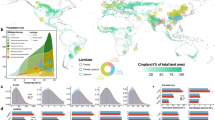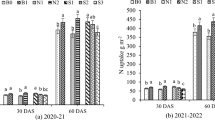Abstract
Background and aims
Only limited information is available in the research area on the effect of elevated CO2 concentration ([CO2]) and air temperature (Tair) on the fertilizer N uptake by rice. This study was conducted to investigate changes in rice uptake of N derived from fertilizer (NDFF) and soil (NDFS) as well as fertilizer N uptake efficiency (FUE) with elevated [CO2] and Tair in two soils with different fertility.
Methods
Rice (Oryza sativa L.) plants were grown with 15N-urea for two growing seasons (2007 in the less fertile and 2008 in the more fertile soil) in temperature gradient chambers under two (ambient and elevated) levels of [CO2] and Tair regimes. At harvest, dry matter (DM) and N uptake amount of rice compartments (root, shoot, and grain) were determined.
Results
The DM of whole rice increased (P < 0.01) with co-elevation of [CO2] and Tair in both years (by 28.0 % in 2007 and by 27.4 % in 2008). The DM in 2008 was greater than that in 2007 by 48.1 to 63.1 % probably due to better soil fertility as well as longer sunshine hours (456 h vs. 568 h). Co-elevation of [CO2] and Tair increased total N uptake, NDFF, and NDFS by 19.4 to 29.1 % in general compared to the ambient conditions. The FUE increased with co-elevation of [CO2] and Tair from 46.5 to 59.5 % in 2007 and from 36.7 to 43.8 % in 2008.
Conclusions
The projected global warming with elevated [CO2] is expected to increase FUE via enhanced DM accumulation with less increments in the soils that have higher indigenous soil N availabilities.




Similar content being viewed by others
References
Ainsworth EA (2008) Rice production in a changing climate: a meta-analysis of responses to elevated carbon dioxide and elevated ozone concentration. Glob Change Biol 14:1642–1650
Baker JT (2004) Yield responses of southern US rice cultivars to CO2 and temperature. Agric For Meteorol 122:129–137
Bronson KF, Hussain F, Pasuquin E, Ladha JK (2000) Use of 15N-labeled soil in measuring nitrogen fertilizer recovery efficiency in transplanted rice. Soil Sci Soc Am J 64:235–239
Cai GX, Freney JR, Humphreys E, Demand OT, Samson M, Simpson JR (1987) Use of surface film to reduce ammonia volatilization from flooded rice fields. Aust J Agric Res 39:177–196
Choung JI, Kim WJ, Lee JK, Lee DJ (1998) Response of cultural environment in introduced rice varieties. Korean J Intl Agr 14:260–266
Coats B (2003) Global rice production. In: Smith CW, Dilday RH (eds) Rice origin, history, technology and production. Wiley, Hoboken, pp 247–470
De Datta SK, Buresh RJ, Samson MI, Kai-Rong W (1988) Nitrogen use efficiency and nitrogen-15 balance in broadcast-seeded flooded and transplanted rice. Soil Sci Soc Am J 52:849–855
Freeman C, Fenner N, Ostle JJ, Kang H, Dowrick DJ, Reynolds B, Lock MA, Sleep D, Hughes S, Hudson J (2004) Export of dissolved organic carbon from peatlands under elevated carbon dioxide level. Nature 430:195–198
Freney JR, Trevitt ACF, De Datta SK, Obcemea WN, Real JG (1990) The interdependence of ammonia volatilization and denitrification as nitrogen loss processes in flooded rice fields in the Philippines. Biol Fertil Soils 9:31–36
Goswami H, Mahi GS, Saikia US (2006) Effect of few important climatic factors on phenology, growth and yield of rice and wheat-a review. Agric Rev 27:223–228
Haefele SM, Wopereis MCS, Ndiaye MK, Barro SE, Ould Isselmou M (2003) Internal nutrient efficiencies, fertilizer recovery rates and indigenous nutrient supply of irrigated lowland rice in Sahelian West Africa. Field Crop Res 80:19–32
Haefele SM, Naklang K, Harnpichitvitaya D, Jearakongman S, Skulkhu E, Romyen P, Phasopa S, Tabtim S, Suriya-arunroj D, Khunthasuvon S, Kraisorakul D, Youngsuk P, Amarante ST, Wade LJ (2006) Factors affecting rice yield and fertilizer response in rainfed lowlands of northeast Thailand. Field Crop Res 98:39–51
Hauck RD, Bremner JM (1976) Use of tracers for soil and fertilizer nitrogen research. Adv Agron 79:965–973
He SL, Alva AK, Calvert DV, Banks DJ (1999) Ammonia volatilization from different fertilizer sources and effects of temperature and soil pH. Soil Sci 164:750–758
Hirzel J, Cordero K, Fernández AJ, Sandoval M, Zagal E (2012) Soil potentially mineralizable nitrogen and its relation to rice production and nitrogen needs in two paddy rice soils of Chile. J Plant Nutr 35:396–412
Hossain MF, White SK, Elahi SF, Sultana N, Choudhury MHK, Alam QK, Rother JA, Gaunt JL (2005) The efficiency of nitrogen fertilizer for rice in Bangladeshi farmers’ fields. Field Crop Res 93:94–107
IPCC (2007) Climate Change 2007: contribution of working groups I, II and III to the Fourth Assessment Report of the Intergovernment Panel on Climate Change. IPCC, Geneva
Jing Q, Bouman BAM, Hengsdijk H, Van Keulen H, Cao W (2007) Exploring options to combine high yields with high nitrogen use efficiencies in irrigated rice in China. Eur J Agron 26:166–177
Kim HY, Horie T, Nakagawa H, Wada K (1996) Effects of elevated CO2 concentration and high temperature on growth and yield of rice. Jpn J Crop Sci 65:634–643
Kim HY, Lieffering M, Miura S, Kobayashi K, Okada M (2001) Growth and nitrogen uptake of CO2-enriched rice under field conditions. New Phytol 150:223–229
Kim HY, Lieffering M, Kobayashi K, Okada M, Mitchell MW, Gumpertz M (2003a) Effects of free-air CO2 enrichment and nitrogen supply on the yield of temperate paddy rice crops. Field Crop Res 83:261–270
Kim HY, Lieffering M, Kobayashi K, Okadas M, Miura S (2003b) Seasonal changes in the effects of elevated CO2 on rice at three levels of nitrogen supply: a free air CO2 enrichment (FACE) experiment. Glob Change Biol 9:826–837
Kim HY, Lim SS, Kwak JH, Lee DS, Lee SM, Ro HM, Choi WJ (2011) Dry matter and nitrogen accumulation and partitioning in rice (Oryza sativa L.) exposed to experimental warming with elevated CO2. Plant Soil 342:59–71
Krishnan P, Swain DK, Bhaskar BC, Nayak SK, Dash RN (2007) Impact of elevated CO2 and temperature on rice yield and methods of adaptation as evaluated by crop simulation studies. Agric Ecosyst Environ 122:233–242
Lam SK, Chen D, Norton R, Armstrong R (2012a) Nitrogen demand and the recovery of 15N-labelled fertilizer in wheat grown under elevated carbon dioxide in southern Australia. Nutr Cycl Agroecosyst 92:133–144
Lam SK, Han X, Lin E, Norton R, Chen D (2012b) Does elevated atmospheric carbon dioxide concentration increase wheat nitrogen demand and recovery of nitrogen applied at stem elongation? Agric Ecosyst Environ 155:142–146
Lim SS, Kwak JH, Lee DS, Lee SI, Park HJ, Kim HY, Nam HS, Cho KM, Choi WJ (2009) Ammonia volatilization from rice paddy soils fertilized with 15N-urea under elevated CO2 and temperature. Korean J Environ Agric 28:233–237
Lin WH, Ziska LH, Namuco OS, Bai K (1997) The interaction of high temperature and elevated CO2 on photosynthetic acclimation of single leaves of rice in situ. Physiol Plant 99:178–184
Matsui T, Namuco OS, Ziska LH, Hone T (1997) Effects of high temperature and CO2 concentration on spiklet sterility in indica rice. Field Crop Res 51:213–219
Nakagawa H, Horie T (2000) Rice responses to elevated CO2 and temperature. Glob Environ Res 3:101–113
Nissen TM, Wander MM (2003) Management and soil-quality effects on fertilizer-use efficiency and leaching. Soil Sci Soc Am J 67:1524–1532
Olk DC, Cassman KG, Simbahan G, Sta Cruz PC, Abdulrachman S, Nagarajan R, Tan PS, Satawathananont S (1999) Interpreting fertilizer-use efficiency in relation to soil nutrient-supplying capacity, factor productivity, and agronomic efficiency. Nutr Cycl Agroecosyst 53:35–41
Peng S, Garcia FV, Laza RC, Sanico AL, Visperas RM, Cassman KG (1996) Increased nitrogen use efficiency using a chlorophyll meter in high yielding irrigated rice. Field Crop Res 47:243–252
Peng S, Buresh RJ, Huang J, Zhong X, Zou X, Zou Y, Yang J, Wang G, Liu Y, Hu R, Tang Q, Cui K, Zhang F, Dobermann A (2010) Improving nitrogen fertilization in rice by site-specific N management: a review. Agron Sustain Dev 30:649–656
Rowland-Banford AJ, Baker JT, Allen LH Jr, Bowes G (1996) Interactions of CO2 enrichment and temperature on carbohydrate accumulation and partitioning in rice. Environ Exp Bot 36:111–124
Schnier HF (1994) Nitrogen-15 recovery fraction in flooded tropical rice as affected by added nitrogen interaction. Eur J Agron 3:161–167
Weerakoon WMW, Ingram KT, Moss DN (2005) Atmospheric CO2 concentration effects on N partitioning and fertilizer N recovery in field grown rice (Oryza sativa L.). Agric Ecosyst Environ 108:342–349
Yang LX, Huang JY, Yang HJ, Zhu JG, Liu HJ, Dong GC, Liu G, Han Y, Wang YL (2006) The impacts of free-air CO2 enrichment (FACE) and N supply on yield formation of rice crops with large panicle. Field Crop Res 98:141–150
Yang LX, Huang HY, Yang HJ, Dong GC, Liu HJ, Liu G, Zhu JG, Wang YL (2007) Seasonal changes in the effects of free-air CO2 enrichment (FACE) on nitrogen (N) uptake and utilization of rice at three levels of N fertilization. Field Crop Res 100:189–199
Yang LX, Wang YL, Kobayashi K, Zhu JG, Huang JY, Yang HJ, Wang YX, Dong GC, Liu G, Han Y, Shan YH, Hu J, Zhou J (2008) Seasonal changes in the effects of free-air CO2 enrichment (FACE) on growth, morphology and physiology of rice root at three levels of nitrogen fertilization. Glob Change Biol 14:1844–1853
Yun SI, Kang BM, Lim SS, Choi WJ, Ko JH, Yoon SH, Ro HM, Kim HY (2012) Further understanding CH4 emission from a flooded rice field exposed to experimental warming with elevated [CO2]. Agric For Meteorol 154–155:75–83
Ziska LH, Namuco O, Moya T, Quilang J (1997) Growth and yield responses of field-grown tropical rice to increasing carbon dioxide and air temperature. Agron J 89:45–53
Acknowledgements
This research was supported by grants from the National Research Foundation of Korea (NRF) funded by the Ministry of Education, Science and Technology (code: 311-2006-2-F00039) and from the Cooperative Research Program for Agricultural Science & Technology Development (Project No. 200712A01033200), Rural Development Administration, Republic of Korea. The authors would also like to thank Mr. Yong-Se Park at National Instrumentation Center for Environmental Management, Seoul National University for the operation of the Stable Isotope Ratio Mass Spectrometer (IsoPrime-EA, NFEC-1990-07-019779).
Author information
Authors and Affiliations
Corresponding authors
Additional information
Responsible Editor: Per Ambus.
Rights and permissions
About this article
Cite this article
Nam, HS., Kwak, JH., Lim, SS. et al. Fertilizer N uptake of paddy rice in two soils with different fertility under experimental warming with elevated CO2 . Plant Soil 369, 563–575 (2013). https://doi.org/10.1007/s11104-013-1598-z
Received:
Accepted:
Published:
Issue Date:
DOI: https://doi.org/10.1007/s11104-013-1598-z




